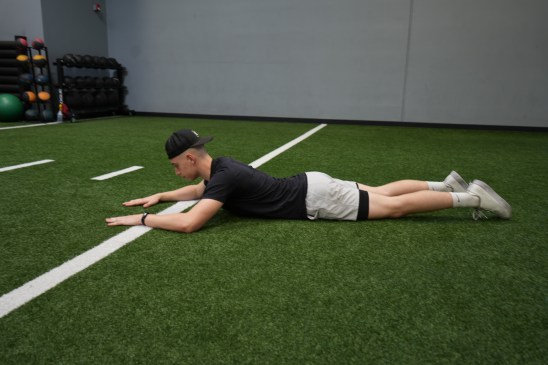Table of Contents
The real reason your traps are tight
The upper trap, the muscle along the sides of your neck, is a common cause of neck pain and tension.
Most people try to fix this tension by stretching their necks.
But I hate to break it to you…
Stretching doesn’t work
That’s because the upper trap is NOT tight for the reasons you’d think it was.
In this post, I’ll give you the REAL reason the upper trap gets tight, and what you can do about it.
Check it out below.
How the thorax influences the upper trap tightness
I want you to run an experiment.
Sit up in your chair and reach one of your arms forward. Take to your other hand and place it on your upper trap muscle on the reaching side.
Now, keep your hand on your trap and slouch.
Did you notice a difference in how tense your trap felt?
Slouching increases upper trap muscle tension. In fact, it’s likely the most overlooked reason for tight upper traps. This body orientation is one reason why stretching the upper trap does NOTHING.

The other reason? According to contemporary research, stretching likely works by increasing stretch tolerance. Though stretching may reduce pain, (this study), but it will not influence the thorax.
So is the fix to sit up straight?
NO.
God no.
And that’s because most people don’t grasp what is actually happening when slouching occurs.
What everyone gets wrong about slouching
Slouching isn’t some magical posture we assume because we are lazy, on a computer, or text too much.
It actually has more to do with the shape our thorax assumes to better help us breathe.
The anterior thorax (front of the chest moves as we breathe. Upon inhalation, this area moves forward and upward. With exhalation, it moves backward and downward.

Either motion can become restricted. In regards to trap tightness, we will focus on an inhalation restriction.
If the anterior thorax can’t expand, the upper back will appear more rounded. With this shape, you’ll see the following occur at the head and shoulder blades:
– Forward head posture
– Slumped and elevated shoulder blades
– Elevated clavicle (collarbone)
Guess what these actions do to the upper trap? This muscle’s functions are clavicle elevate and head extension (this study). Thus, this body shape increases muscle activity along the ENTIRE upper trap.
Sitting upright will neither change anterior thorax expansion nor impact upper trap tightness. These two movements are one and the same
The real solution? Improve chest wall dynamics.
Here’s how.
Expand the thorax = loosen up the neck
To drive air into the chest, we will take advantage of two factors:
- Gravity
- Arm position
If our chest faces the ground (prone-based postures), gravity will tend to bias more air to the front of the chest.

90º-120º shoulder flexion reaches will eccentrically bias chest wall musculature.

Put ’em together, and your chest will expand LIKE WHOA!
When breathing in these positions, there are two major keys to focus on:
- Quietly inhale in the nose (don’t force it, that’ll increase muscle tension)
- Exhale slowly and softly through the mouth, feeling the lower abs get smaller
Force nothing. Trying too hard will increase muscle tension, limiting your mobility gains.
The easiest position to start is prone on elbows:
Progress the intensity of this position by reducing how much of your body is on the ground. Frog breathing is a great example:
Still too easy? Narrow the base of support with quadruped on elbows:
Then if you want to get nasty, go bear on elbows:
Though these drill ROCK at improving mobility, none of them are upright. To increase daily life transfer, you’ll want to up the challenge.
For that, I like landmine presses. The bent-over landmine press is an excellent variation to perform:
Sum up
Utilizing these principles and tactics, there is no doubt your upper trap will be less tight.
To recap:
- Upper trap tightness occurs with anterior thorax mobility restrictions
- If the chest wall can’t move, the head juts forward, increasing upper trap activity
- To relieve tension, choose exercises that promote expansion in the anterior thorax
What exercises have you found useful for relieving trap tension? Comment below and let us know.
